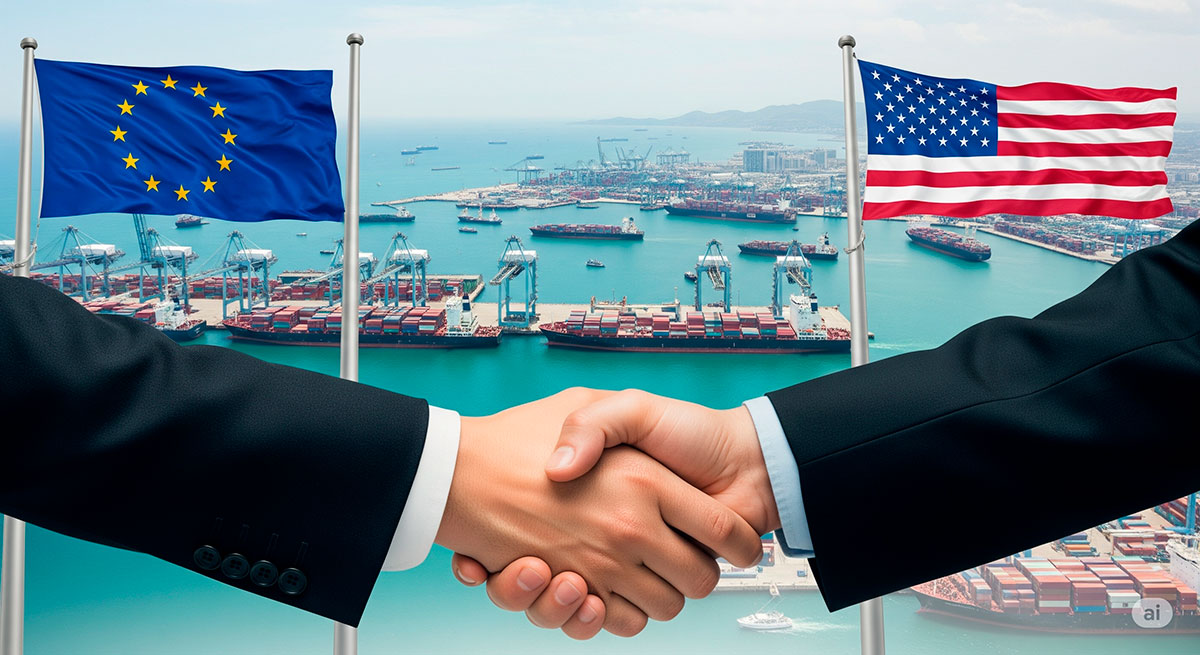Brussels and Washington avoid a total commercial war with a last minute pact. However, the agreement, which imposes a 15% fixed tariff on European products, has been received with falls in European stock markets and a generalized analysis that the EU has yielded to avoid greater evil.
At a high -level meeting held this Sunday in Scotland, the president of the United States, Donald Trump, and the president of the European Commission, Ursula von der Leyen, announced a commercial agreement that ends, for now, months of tension and the imminent threat of a tariff climb. As of August 1, the dreaded 30% American tariff on European exports is avoided, but a fixed and generalized tariff of 15% for practically all EU products that enter the US market, including sectors as sensitive as the car.
The pact, qualified as "a good agreement for all" by President Trump, contemplates significant commitments by the European Union. Brussels has pledged to make mass purchases of American energy for an approximate value of 750,000 million dollars and to invest additional 600,000 million in the US military equipment. In exchange for these concessions and accepting the 15%tariff, the EU achieves that US products enter into their market with a zero tariff, which many analysts have already described as "asymmetric agreement."
Immediate market reaction: relief and punishment
The reaction of the financial markets has not been expected and reflects the bittersweet nature of the pact. Although the uncertainty of a large -scale commercial war has been dissipated - the worst possible scenarios - the cost for European companies is undeniable.
- European Bags down: in the session on Monday, the main European stock market rates have registered falls. The Stoxx 50 euro has suffered with special virulence in the most exposed sectors. Automobile companies such as Volkswagen and consumer goods such as alcoholic beverage manufacturers (Pernod Ricard, Anheuser-Busch Inbev) have led losses, with falls greater than 3%. In Spain, Ibex 35 has shown more moderate behavior, but the general tonic has been red numbers.
- The euro weakens: in the currency market, the euro has reacted with a strong outward correction against the dollar, registering one of its worst days of recent months. The strength of the dollar is driven by the perception that the United States is strengthened from the agreement.
- Wall Street, Mixed: On the other side of the Atlantic, the reaction has been more contained, with Wall Street quoting mixedly. The agreement eliminates a focus of instability, but the imposition of new tariffs can also have an impact on the costs of US companies that depend on European suppliers.
Economic analysis: Who wins and who loses?
Beyond the immediate reaction of the bags, the medium and long -term analysis reveals a complex panorama for both economic blocks.
For the European Union:
The main victory for the EU is to have avoided a 30%rate, which would have been devastating for its export industry. The agreement provides stability and certainty , two elements highly valued by companies. However, the price to pay is high:
- Loss of competitiveness: a fixed 15% tariff will make European products in its main export market, which will mean a direct loss of competitiveness against local products or other countries. Sectors such as Spanish olive oil, French wine or German cars will be directly affected.
- Strategic assignment: The massive purchase commitment of energy and military material to the EU to the United States in strategic sectors, reducing its autonomy and diversification of suppliers. Politically, many analysts see it as a significant concession that weakens the negotiating position of Brussels in the future.
- Inequal impact: Not all EU countries will suffer equally. Economies such as German, with a strong industrial export component to the US, will be more vulnerable. The Bank of Spain, meanwhile, has estimated that the impact on the Spanish economy could be more "limited" than in other partners, due to a lower relative weight of goods with the US in its GDP.
For the United States:
From the American perspective, the agreement is presented as a clear victory on several fronts:
- Political and economic achievement: The Trump administration manages to impose its negotiation framework, ensuring a flow of income through tariffs and, above all, guaranteeing mass sales for its energy sector.
- Strengthening of the dollar: the weakness of the euro and the perception of a favorable agreement to strengthen the dollar, which has implications in global capital flows.
- Possible counterproductive effects: despite the advantages, the US economy is not immune to the negative effects. Tariffs are ultimately a tax that can end up being paid by US consumers and companies through higher prices and a possible inflationary pressure.
In short, the tariff agreement between the EU and the US has managed to deactivate a commercial clock bomb, but has left an unbalanced playfield. For the European Union, it is a expensive truce that forces its companies to adapt to a new less favorable scenario, while for the United States, it represents a success in its bilateral negotiation strategy. The coming months will be key to evaluating the true scope of this pact and how both economic giants reconfigure their commercial relations.







































